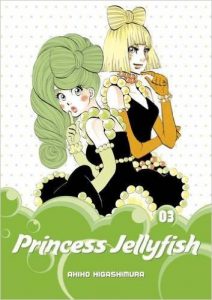By Akiko Higashimura. Released in Japan in two separate volumes as “Kuragehime” by Kodansha, serialization ongoing in the magazine Kiss. Released in North America by Kodansha Comics. Translated by Sarah Alys Lindholm.
After waffling a bit about the first two omnibuses of this series, the third settles in more comfortably into something I’m really enjoying. The characters develop a bit more, though that’s not always a good thing. The humor can be first rate much of the time. And the overwhelming sense of impending doom is done with a light but necessary touch, as we never forget even from the start that Amars’ home is about to be taken away from them – indeed, the owner (Chieko’s mother, who amusingly also seems to be a giant otaku, this time for Korean actors) signs off on selling it, so we’re left wondering what can possibly be left to save it? Ah, but in the best Mickey Rooney/Judy Garland tradition, Kuranosuke has the answer – we’re gonna put on a show!
Actually, the show was my favorite part of this whole volume – not the fashion show that serves as the cliffhanger ending, but the college drama that they all go to see in order to fill up seats, that fires up Karanosuke’s arrogant fashion heart and leads to all this. College productions can be hilarious at times, and the idea of a huge number of Ophelia clones fighting it out over Hamlet is exactly the sort of play you’d likely see in a hardcore drama department. Likewise, the shoestring budget and slapdash costumes also fit in, even if they upset the aesthetic sense. It’s nice to see Tsukimi manage to overcome her introversion and get everyone sewing so we can get the jellyfish dresses, even if I did groan as Kuranosuke once again forced her into a big social situation without telling her.
And then there’s Inari. I still don’t like her – by design, she’s the villain – but I also wasn’t fond of the plotline in this volume. Her faked suicide looked and felt offhand, as if she threw it together uncaringly, though I was fine with Shu being upset about her doing it. The fact that she started to fall for him for real after he hit her upset me a bit, though I know it wasn’t meant to be taken that way. In reality, it’s that he actually cares about her well-being and isn’t just another male body on the sexual corporate ladder. Still, I wish we could have had that without the violence. That said, I was amused at how she seemingly falls apart a bit after that, to the point where she can’t even blackmail him properly.
The rest of Amars also fare well, getting things to do to flesh them out. Mayaya gets the most, of course, as she’s the one with the body of a model and the personality of a fruitcake. We get into the background of the cast in greater depth here – Mayaya hides her eyes as they’re evil-looking, similar to the hero in Toradora!. But everyone in Amars is quick to remind her that they all went through that sort of thing – they were all bullied in school for being different. I’m not sure how long Mayaya’s actual modeling career may last – and I note that if she ends up with the Benz freak it would be hilarious – but it’s amusing and inspiring at the same time.
To sum up, while I still have a few issues with Princess Jellyfish, I enjoyed this omnibus a lot more, and it’s a solid josei title for young women or anyone.


Speak Your Mind